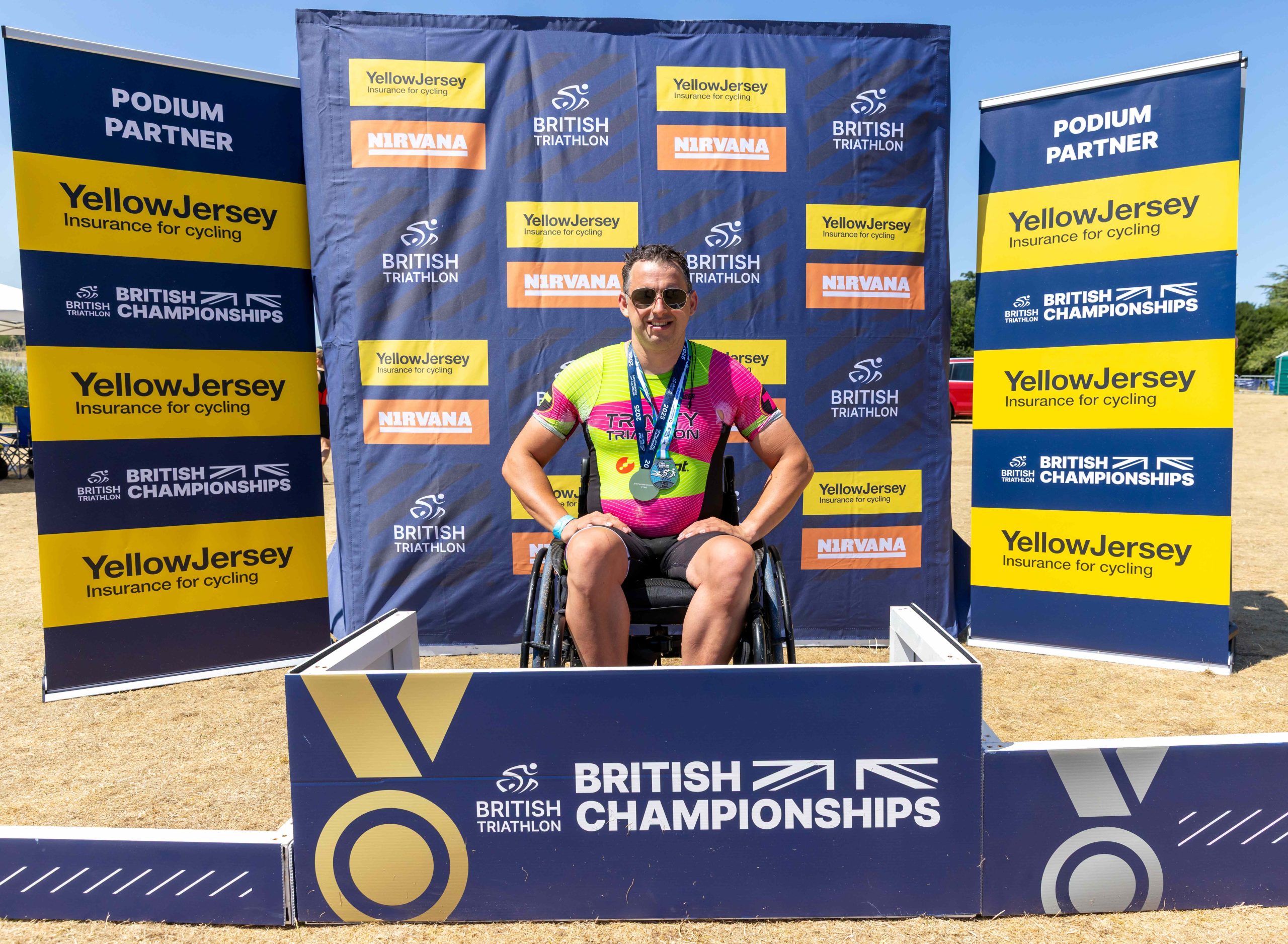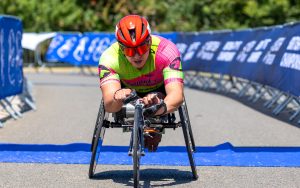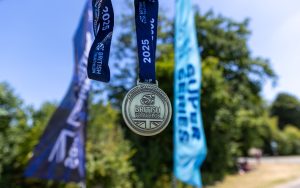
Paratri
A Super Series Insider Review of the British Paratriathlon Championships
James Bilham competes in the wheelchair category in the Paratri Super Series. Having previously given us his Insider Perspective on Llanelli back in May, he’s back to tell us all about the British Paratriathlon Championships that took place at Eton Dorney in July.
An iconic Olympic venue. My A race. Scorching hot day in July. It must be the National Championships. We. Are. On!
Eton Dorney is my favourite venue for para racing in the UK. Not only is it an iconic venue from the Olympic rowing races, but the bike and run circuits are flat and fast and there is always a packed crowd.
I’d prepared for the race well in advance and everything was packed. I wasn’t travelling with my tri coach Laura this time, as she was off running some trails, so I booked a room at a Premier Inn near Eton Dorney for the night before, so that I could avoid travel on the day of the race. Settling into the hotel was no trouble at all, Premier Inns have become my go to hotel choice on my travels. The rooms are always clean, there is plenty of space to move around in a wheelchair and the onsite food options – whilst not always perfect choices for athletes – are convenient.
By the time I arrived in my room I was exhausted from the travelling, one of the less talked about effects of spinal cord injury is cognitive fatigue. A day of travelling is exhausting, so I had a power nap, a quick shower and I headed for dinner. I always make sure to get a decent night of carbs the night before a race. On this occasion it was nachos, tagliatelle and a pancake stack. I’d prefer chicken and rice but I enjoyed it nonetheless! I didn’t have any problem getting to sleep – a long day and a full stomach and I was out like a light.
Race morning!
Everything was ready and I was preparing for a hot day, so immediately on waking up I make an electrolyte drink and headed down for breakfast. I wasn’t racing until 11:30, so I had plenty of time to digest a decent breakfast of eggs on toast, granola with yoghurt and fruit, pancakes and the all-important coffee!
It’s strange travelling to a race without Laura in support. Dinner and breakfast are a little quieter for sure, but everything is a little harder in a wheelchair, getting buffet style food and drink to the table, we need our hands to push the chair, the same as carrying luggage. Like most wheelchair users, I find a way and I’m lucky to be able to move short distances on my feet, but these little extra efforts are noticeable.
After breakfast it’s off to the venue where my parents meet me to take on the role of Laura and provide support. I got registered, we unloaded the car and I got set up for my warmup in the shade of the cars at the car park. It was 9:30am and already incredibly warm and I was nervous about the heat, having suffered at Llanelli earlier in the year and I wanted to control whatever I could. My mum questioned the logic of warming up with an ice pack in my jersey! Once warmed up we mixed up my drinks with plenty of ice, got my kit ready and down to transition. It’s easy when you know how!
There was a lot of debate about whether to wear a wetsuit or not. It was definitely warm enough to not wear one and in some races it had been forbidden. As PTWC athletes we can wear wetsuit bottoms in any conditions as our legs simply sink otherwise. Mine were brand new and I was worried they might be tight to remove, so my Dad and I did a little bit of pre-race testing, a bit of baby oil and some awkward breakdancing and we decided they were fine, so I got ready for the start.
The race!
British Championships means each category has their own start, so with a small PTWC field there was no mass start this time. The PTWC H1 athletes go off first, and then the H2 athletes set off three minutes later. As an H2 athlete, I jump in with the H1s, watch them set off and wait for my warning. 30 seconds to go I put my head in the water. It’s warm. I’m ready. 10 seconds to go. 3,2,1 – Horn. I go. I set off after the H1 athletes.
I feel really comfortable in the water. I’ve got a really nice rhythm going and get to the first buoy feeling pretty happy. My line could have been straighter and I make a point of sighting more often for the rest of the swim. I don’t have a good grasp of pace or time in the swim, but I feel very much in control as we reach the exit and two of the support team are ready and waiting for me. They scoop me out and I get a lift all the way up the ramp to the end of the blue carpet – this is relief for my dad, he hasn’t had to push me up the ramp!
Transition one and onto the handcycle
Into transition, out of my wheelchair onto the floor. The wetsuit bottoms come off no dramas, dance moves saved for another day, and I’m straight into my handcycle. The transition was as smooth as I could have hoped for as I roll out to the mount line and out onto the circuit.
There are riders still on circuit from the earlier races and they provide my motivation and a target. I’m feeling strong and fresh and I’m super aero down low in my handcycle and I start closing the distance pretty quick. I’m in the lead, I’ve passed the H1 athletes in the swim and I’ve got the road out in front of me.
It’s incredibly warm and as I’m laying back on the handcycle I have to remind myself it’s not a sun lounger! I later checked and my Garmin recorded temperatures between 32 and 36 on the ride, so it was definitely pretty warm.
The cycle leg is four laps and I’m using the lap markers as my guide for fuelling. Remembering to take on fluids each lap, and a caffeine gel halfway through. It’s hot and I know I need to fuel and try to keep cool!
Each lap I see my parents cheering me on as I round the final corner and cross the bridge. The support and motivation of friends and family makes such a huge difference, but the support of strangers is amazing.
I can’t talk about the event without mentioning the incredible support of the safety team and the marshals. From the swim supports in their kayaks, marshals seeking shade under umbrellas at the furthest points on the course, helpers handing out water at fuel stations and the technical officials throughout the event. Without them, events just wouldn’t happen and the support they give is relentless!

Transition Two and into the chair
Into T2 and a change into the racing chair. Cramps and spasms again. It always happens in T2. I shuffle around and relieve the pain enough to get into the race chair and get started.
Some of the H1 athletes had cut their bike leg short due to their own medical concerns so were out in front of me on the run, although no longer officially part of the race. Each person is taking on their own challenge, fighting their own battles and seeking their own victories.
As I make my way out of transition I catch sight of my brother, sister in law and my niece and nephew cheering on from the sides. It’s so motivating to think I might be inspiring another generation.
As I set off onto the run, I can see the H1 athletes that had cut their rides short in front of me, but like a mirage in the haze of the heat they didn’t seem to be getting closer. My racing chair had a slight mechanical problem, the chest support wasn’t holding in place, so I was in a very uncomfortable position. It was causing spasms in my hips and also making it much harder for me to breathe effectively, I know I just need to get through this now. As I rounded the turn point at the 2.5km mark, I settled into a new rhythm and with the momentum of the downhill run I finally caught the last H1 athlete on the circuit. As I approached the final corner, I could hear my family cheering me on again and I crossed the line as the winner. James Bilham, PTWC, British Champion.
Crossing the line, I was relieved to see Emma from British Triathlon, a familiar friendly face to help me out of the chair so I could relieve my cramp whilst my Dad grabbed my wheelchair in time for me to celebrate the final athletes crossing the line! It turned out that Sophie West and Josh Garrett who I met on a British triathlon pathway day also won gold in their categories. It turns out Emma has an eye for talent!

Inspiring the next generation
They say triathlon is for those of us that don’t realise one sport is hard enough. For para athletes and especially those with acquired injuries, we are often competing in sports our bodies aren’t really designed for, in the way that swimming, cycling and running are skills, as humans, we are built for and learn from very young ages. As para athletes, we have to learn something completely new, often as adults.
Winning the British Championships isn’t an aim I expected to achieve in my second year of racing. It’s a great reminder not just to myself of how far I’ve come, but also for others, like those in the early days of recovery from a spinal cord injury or similar, of what you can achieve when things look pretty tough. Less than three years ago I hadn’t even made it out of general hospital into the spinal injury unit. I don’t say this as a boast, although I am proud I could go from a complete novice to national champion in less than two years, while on a second hand handcycle and borrowed racing chair. What I really want to say to anybody looking at parasport and all the challenges it brings, is you can achieve great things.
I’m a grumpy old man now, with some failing body parts and a stubborn personality, but I’m British Champion. If I can do it, anybody can. I genuinely hope it will inspire others, maybe the next generation of Paralympians who are wondering if they can do it or where they might find motivation.
There are a couple of races left this year but with my A race completed, my focus turns to the building blocks for winter. I’ll be working on my form and technique in the swim and racing chair, and building the fitness foundations on the handbike.